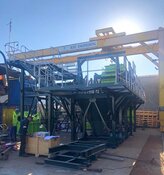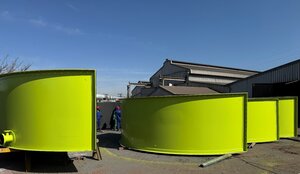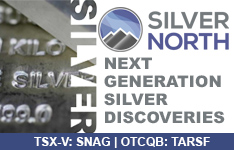Lithium Ionic Corp. (LTH:TSX.V; LTHCF:OTCQX; H3N:FSE) announced it has secured a non-binding Letter of Interest (LOI) from the Export-Import Bank of the United States (EXIM) to provide up to US$266 million in debt financing for the Bandeira Lithium Project in Minas Gerais, Brazil. This financing, representing 100% of the capital expenditure (CAPEX) outlined in the May 2024 Feasibility Study, positions the project as a significant contributor to the global battery supply chain.
EXIM's financial backing highlights the alignment of the Bandeira Project with its China and Transformational Export Program (CTEP), which focuses on critical minerals vital for energy security and electrification. With a maximum repayment term of 15 years, this commitment underscores the strategic importance of Bandeira.
The Bandeira Project's Feasibility Study detailed a 14-year mine life, annual production of 178,000 tonnes of high-grade 5.5% Li2O spodumene concentrate, and low on-site operating costs of US$444/t, and an all-in delivered cost of approximately US$557/t (CIF, Shanghai), positioning it as a competitive operation despite current lithium price environments. The spot price for spodumene concentrate (min. 6% Li2O; CIF China) is currently approximately 800$/t. The post-tax net present value (NPV) of the project is US$1.3 billion, with an internal rate of return (IRR) of 40%. Additionally, Bandeira benefits from access to established infrastructure, including low-cost hydroelectric power, robust transport networks, and proximity to export markets via nearby ports.
Lithium Ionic CEO Blake Hylands highlighted the importance of this achievement, stating in the news release, "This Letter of Interest from EXIM is a major milestone for Lithium Ionic, providing a clear pathway to fully fund the development of the Bandeira Project. It reflects the project's viability, the strength of our team, and the growing importance of Brazil's Lithium Valley in global electrification efforts."
The LOI remains subject to EXIM's due diligence, funding application, and customary approval processes.
Third-Party Analysis of Lithium Ionic
As Varun Arora of Clarus Securities wrote on November 27, 2024, the non-binding LOI from the Export-Import Bank of the United States (EXIM) represented a major de-risking milestone for the Bandeira Project.
Arora stated, "Securing up to 100% of the project CAPEX in non-dilutive financing with a U.S. gov. agency, a highly coveted strategic partner, is a big win for the project and the team." He highlighted the project's strategic alignment with EXIM's China and Transformational Export Program (CTEP), noting its importance in securing critical mineral supplies for the United States.
Varun Arora of Clarus Securities rated Lithium Ionic as a "Speculative Buy" with a price target of US$8.00.
Arora rated Lithium Ionic as a "Speculative Buy" with a price target of US$8.00, citing robust project economics, significant exploration upside, and the project's proximity to production. He estimated that optimized mine sequencing and additional inferred resources could increase Bandeira's NPV to US$1.7 billion, extending the mine life by up to 20 years.
According to analyst Greg Jones of BMO Capital Partners on November 28, 2024, the Bandeira Lithium Project was positioned as a cornerstone of Lithium Ionic's growth strategy due to its strong economic metrics and strategic location in Brazil's Lithium Valley. Jones referenced the May 2024 Feasibility Study, which projected a post-tax net present value (NPV) of US$1.3 billion and an internal rate of return (IRR) of 40%.
He highlighted the project's competitive operating costs of US$444 per tonne and annual production of 178,000 tonnes of 5.5% Li2O spodumene concentrate, emphasizing its global competitiveness. Jones noted that the project's low-cost hydroelectric power, access to transport infrastructure, and proximity to export markets provided further advantages, making it a significant player in the lithium sector. He described the project's alignment with global electrification trends and renewable energy demand as critical to its strategic value.
A Deeper Look Into The Lithium Sector
On November 26, Research and Markets published findings on the global solar battery market, noting the dominant role of lithium-ion batteries, which accounted for an estimated 83.8% share of the solar battery market in 2024. Lithium-ion batteries were favored for their superior energy density, efficiency, and longer lifespan, making them ideal for industrial and residential applications. The report projected the global solar battery market would grow from US$257.3 million in 2024 to US$617.5 million by 2030, driven by the declining costs of solar technologies and increasing demand for energy storage solutions to enhance grid stability and support renewable energy systems.
As Allied Analytics reported on November 27, the global lithium-ion battery recycling market was projected to grow from a valuation of US$1.33 billion in 2020 to US$38.21 billion by 2030. This would include a compound annual growth rate (CAGR) of 36%. Key drivers included the rising adoption of electric vehicles (EVs), renewable energy storage, and consumer electronics. Recycling was noted as a crucial practice to recover valuable materials, reduce reliance on mining, and minimize environmental and safety risks. Asia-Pacific was identified as the fastest-growing region for lithium-ion battery recycling, with an anticipated CAGR of 40.8% during the forecast period.
On that same day, Fastmarkets highlighted significant growth in the supply of scrap lithium-ion batteries. The site forecasted an increase from 96,000 tonnes in 2024 to 252,000 tonnes by 2029 in Europe alone. However, the economic viability of recycling operations faced challenges, including a significant decline in battery metal prices. Lithium carbonate spot prices, for example, averaged US$10.56–11.33 per kilogram in November 2024, down sharply from the previous year. Despite these challenges, research suggested opportunities in scaling operations and addressing the increasing volume of battery scrap in the coming years.
Lithium Ionic's Catalysts
The Bandeira Lithium Project has been positioned as a cornerstone of Lithium Ionic's growth strategy, leveraging its location within Brazil's Lithium Valley and robust economic metrics. According to the May 2024 Feasibility Study, the project was projected to deliver a post-tax net present value (NPV) of US$1.3 billion with an internal rate of return (IRR) of 40%. Annual production of 178,000 tonnes of 5.5% Li2O spodumene concentrate, and low operating costs of US$444 per tonne were expected to enhance its competitive standing in the global lithium market. These metrics have been supported by the project's access to low-cost hydroelectric power, established transport networks, and proximity to export markets.
The permitting and engineering phases for Bandeira have progressed, and production could start as soon as the second half of 2026. The project's significance extended beyond its financial returns. As the company noted in its investor presentation, Bandeira aligns with global electrification trends and the increasing demand for critical minerals in renewable energy and battery production. This alignment has been bolstered by EXIM's recent LOI, emphasizing the project's potential role in the U.S.'s energy security and supply chain resilience.
Streetwise Ownership Overview*
Lithium Ionic Corp. (TSX-V: LTH;OTCQX: LTHCF;FSE: H3N)
Ownership and Share Structure
According to the company, management and insiders own 20% of the Lithium Ionic.
One of the insiders, President & Director Helio Diniz, owns 5.52%, Director Michael Lawrence Guy owns 5.10%, Director David Patrick Gower owns 2.56%, and Andre Rezende Gumaraes owns 2.52%, according to Reuters.
30% is held by institutional investors. Reuters reports Waratah Captial Advisors owns 7.01%, JGP Gestao de Recursos Ltda owns 2.69%, RBC Global Asset Management Inc owns 1.94%, Sprott Asset Management LP owns 1.55%, BMO Asset Management owns 1.30%, and IXIOS Asset Management SA owns 1.20%. The rest is retail.
Lithium Ionic has 158.58 million shares outstanding and 131.15 million free-float traded shares.
The company's market cap is CA$135 million, and it trades in a 52-week range of CA$0.41 - 2.24 per share.
| Want to be the first to know about interesting Cobalt / Lithium / Manganese investment ideas? Sign up to receive the FREE Streetwise Reports' newsletter. | Subscribe |
Important Disclosures:
- Lithium Ionic Corp. is a billboard sponsor of Streetwise Reports and pays SWR a monthly sponsorship fee between US$4,000 and US$5,000.
- James Guttman wrote this article for Streetwise Reports LLC and provides services to Streetwise Reports as an employee.
- This article does not constitute investment advice and is not a solicitation for any investment. Streetwise Reports does not render general or specific investment advice and the information on Streetwise Reports should not be considered a recommendation to buy or sell any security. Each reader is encouraged to consult with his or her personal financial adviser and perform their own comprehensive investment research. By opening this page, each reader accepts and agrees to Streetwise Reports' terms of use and full legal disclaimer. Streetwise Reports does not endorse or recommend the business, products, services or securities of any company.
For additional disclosures, please click here.










































